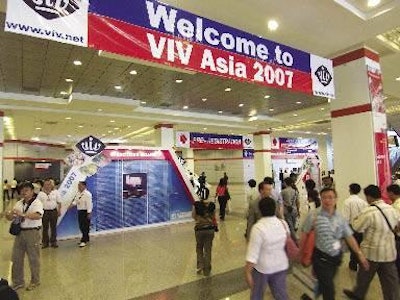
A rich mixture of Oriental and Occidental greeted visitors at the latest VIV Asia exhibition in Bangkok during March. Compared with previous editions of the show, there were noticeably more Asian exhibitors alongside the usual ranks of Europe-based suppliers. For the first time in the event's 14-year history in Thailand's capital city there were more companies from China than from the Netherlands or the host country. Korea also figured in the list of most represented countries alongside the USA, France, Italy, Spain, Germany and the UK.
Facts and figures for the 8th edition of the show revealed an 18% increase in net surface area from 2 years ago, to 11 800m², and 10% more exhibitors at 518 from 37 countries. The organisers reckoned that 37% of all stands related to equipment and genetics for farm production and 9% to slaughtering/processing, but the largest single segment at 54% was composed of those offering feed ingredients, additives and animal health products. Attendance for the 3-day event held up at a total of 21 726 visitors from 92 countries.
By an unfortunate coincidence, each time the biennial VIV Asia visits Bangkok there is a downturn in local pig prices! It happened again in March. The most obvious sign was that Thai producers were once more selling some of their output at suckling pigs in a bid to push up price levels by reducing supplies sent at the usual 80-100kg slaughter weight. Possibly the effects of the market deterred some Thailand-based people from visiting the show, but the overall attendance still added up to a bonanza. Visitor numbers exceeded 22 000 and they came from over 100 countries.
Talk of the current pig market in Thailand confirmed that official data on sow numbers still under-state the true situation. Well informed estimates put the size of the Thai national pig breeding herd at 1.1 million sows after a period of expansion over the last 12 months. The 2 largest pig production companies in the country have both expanded considerably during that time. Charoen Pokphand (CP) is thought to have grown by 80 000 sows and Betagro by about 40 000 sows, so these companies alone appear to have added some 12% to the total inventory nationwide. Several others of a smaller scale are reported to have grown by between 5-10%.
Nevertheless, Thai producers attending VIV Asia were adamant that disease presented more of a challenge to their profitability and survival than any short-term excess in the pig supply. In their view the next 2 years would have to bring a breakthrough in achieving effective disease control at unit, area and national levels in order to limit the strain placed by poor health on costs of production.
In fact, the remarkable calculation being made in Thailand in 2007 is that PRRS is responsible for 25-30% of the cost of producing the average pig. Considering the calculated total cost of 42 Baht per kilogram liveweight (approximately equal to US$1.28/kg), this would mean PRRS is costing Thai units about US$32 for every 100kg produced.
Set this against the target that the top producers in Thailand are setting themselves. They say the answer to staying competitive will be to produce at a cost of not more than 35 Baht (US$1.07) per kilogram.
For them as for everyone, of course, actual production costs in the coming months look certain to rise because of the international jump in feed grain prices. The once maize-rich pig feeds found on Thai units have already started to include considerable amounts of manioc (tapioca or cassava) as a corn replacement. Even this material is under pressure because of the ethanol biofuel movement, however. During the week of VIV Asia, newspapers in Thailand were reporting a campaign for extra cassava production by Thai farmers under contract that would provide the input to generate another 1.75 million litres of ethanol daily at Thai plants.
Extra cultivation is needed because Thailand lacks the supply of cassava to meet the demand for feed and fuel. Thai visitors at VIV Asia warned that comparative economics had actually dissuaded cropping with cassava, at a time when the official objective remained to double national tapioca production to 18 million tons per year.
Feed ingredient availability and prices in 2007 dominated conversations throughout the week. The continuing high level of the global grain market due to biofuel and climate pressures was joined by fresh concerns about the lack of an expected correction in milk product prices. Products such as delactosed whey have more than doubled in price over the past six months and sources at VIV Asia said no volumes were available even if a purchaser was prepared to pay. Most traders believed the situation had arisen because supplies of milk products formerly used for feeds had been diverted into the food industry since the middle of 2006. Forecasts heard at the show in Bangkok included that piglet milk replacers would in future rely heavily on materials of vegetable origin. Some starch-derived glucoses should be available to assist in lactose replacement, but the price of dextrose had also increased recently under competition for corn from the bioethanol factories.
The ethanol boom will at least provide a large tonnage of distillers grains (DDGS) for use as a feed ingredient. Addressing a Nutreco face-to-face meeting with representatives of the Asian feed sector Professor Seksom Attamangkune of Kasetsart University in Thailand remarked that the co-product looked set to become accepted widely as an ingredient in livestock feeds because of the quantities coming from the processing of maize at ethanol plants. However, he added, more feeding trials with the material were needed, alongside comparisons of the nutrient profile of DDGS from various international sources.
Dr Seksom declared that a lack of predictability and consistency of nutrients in the co-product represented a challenge to DDGS utilisation. Among other challenges were the absence of a grading system to differentiate quality and price, plus ongoing concerns that concentrated mycotoxins might be present and an issue of flowability that had prompted transloaders to refuse to handle the material from several sources.
At the main VIV Asia conference, Alltech vice-president Steve Bourne suggested that the livestock industry would return to its roots by utilising more of the by-products of food processing. The future would be based on making more use of fibrous materials such as those from biorefineries and processes to derive enzymes by solid-state fermentation. The potential for converting fibre into energy could be worth 300 million tons annually.
Mr Bourne calculated that the global production of pork and poultrymeat in 2000 translated into a requirement for approximately 1.05 billion tons of feeds. Projections for the world meat output indicated this requirement would expand to more than 1.7 billion tons by 2030 and over 2.08 billion tons per year by 2050. It is likely that 75% of this extra demand will be in Asia, he commented. On the latest projections, the Asian countries will already have grown into a marketplace for 391 million tons of pig and poultry feeds by the year 2015. PIGI

















